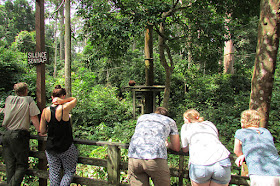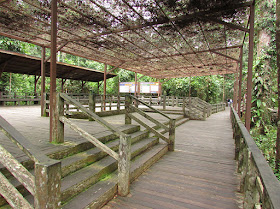The Bornean
Sun Bear Conservation Centre operates as a rescue center for Sun Bears orphaned
as a result of human-wildlife conflicts and Sun Bears that were kept in various
forms of captivity (often as pets). The
BSBCC works to reintroduce the bears to a natural forest environment and
provide them with training in skills such as foraging, climbing trees, nest
building, and self-defense. Although the
ultimate goal is for the bears to be rehabilitated and released into the wild,
some of the bears (especially the ones that were kept as pets) have been in captivity
for so long that they are too dependent upon humans. For these bears, the BSBCC tries to provide
for the welfare of the bears with an environment that is the closest substitute
to actually living in the wild. At the
time of my visit, there were 42 bears being kept at the facility.
Educational Efforts
The BSBCC opened to the public
in 2014, and they make significant efforts to educate their visitors. Upon arriving at the facility, the visitor
notices that there are many explanatory sign boards. There were even sign boards located on the
path between the road and the facility entrance. The below sign explains that the BSBCC is a smoke-free
facility.
This
sign welcomes visitors and acknowledges the many organizations that support the
BSBCC.
This
sign explains the rules of behavior expected from human visitors.
Front
entrance to the visitor center.
In the
visitor center, there was a video presentation that explained the situation of
the Sun Bears in the wild and the work of the BSBCC.
While
moving from the visitor center to the observation deck, visitors encounter additional
sign boards. The sign below reiterated
behavior rules for human visitors.
This sign
board explained the physical characteristics of the Bornean Sun Bear. It is the smallest of all bears.
This
sign board showed the natural geographic range of Sun Bear habitats.
Yet
another sign board about rules: no smoking, no flash photography, observe
quietly, and don’t call out to the bears.
At
the time of our visit, there were also three staff members present on the
observation deck who greeted visitors and shared their knowledge about the Sun
Bears.
Observation Deck Area
The first of two observation
decks overlooked a wooded area about the size of an American Football field. Since the observation decks and aerial
walkways are elevated from about 3 to 8 meters above the ground where the bears
roam, visitors can view the bears in safety.
The
photo below shows the aerial walkway between the first observation deck and the
second observation deck. Notice the
covered section – the Sepilok area is apparently subject to sudden downpours, and
this roofed area offers shelter for visitors caught in the rain while moving
between the first and second observation decks.
View
from the second observation deck. I was
told that the bears in this area are quite independent and do not often come
close enough to be seen by visitors.
Below
is a view of the enclosed area closest to the first observation deck. In this area, visitors could easily view 6
young bears that ranged in age from about 1 year to about 4 years old. Please note the roots of the toppled tree in
the center of the photograph.
A
closer view of the toppled tree reveals a bear sitting among the unearthed
roots.
Up-close
photograph of the bear resting among the roots of the toppled tree.
The
forest in this facility is divided into a number of sections and the bears are
let out each day to roam a designated section depending on their level of
independence. As the bears grow more
independent, they are allowed to roam ever larger zones of the forest, with the
final goal being a complete release. In
the section immediately in front of the observation decks, the youngest bears
can be easily seen, and if you are patient, you will see these bears exhibiting
natural behaviors that you cannot see in a typical zoo. The young Sun Bear in
the below photo busied itself with digging for insects under a fallen tree
branch.


Due to
the existence of the partially-covered observation decks and the wide and clean
aerial walkways, this facility offers a great opportunity to enter the forest without
actually entering the wild. Our group
spent close to 2 hours here observing the bears, and I would recommend others
to do the same. When we first arrived,
some of the bears were sleeping. If we
had taken a quick look and moved on as people usually do at a zoo, we would
have missed seeing all of the action.
After watching the bears for about 20 or 30 minutes, they started
climbing trees. Bornean Sun Bears are arboreal, and they are very good tree
climbers. It was great fun to watch 3 of
them scamper up the same tree and then slide back down.
They
even take naps in the trees.
Sometimes
they get caught in the rain while climbing trees.
Overall,
for a person who loves bears, this facility is a great place to visit. You can feel good about supporting the work of
the BSBCC, and you can feel good as you spend a little quiet time in the
forest.
Opportunities for
Animal Encounters
Although there are no
organized animal encounters at this facility, wild macaques and orangutans that
have graduated from the neighboring Sepilok Orangutan Rehabilitation Centre can
sometimes be viewed at very close range.
The macaque below was walking along the hand rail of the observation
deck, only a few meters away from the human visitors. I was warned to not get too close or to stare
directly at the macaques as they may interpret it as a sign of aggression, and
they may attack in order to stake out their territory.
This
fellow below was sitting in one of the main areas of the observation deck. He acted as if he was the owner of the place.
A pair
of orangutans also made an appearance, coming within a meter or so of the
tourists standing under the shelter of a walkway roof.
Food and Souvenirs
There is no food concession at
this facility, but there is a café in front of the Sepilok Orangutan
Rehabilitation Centre next door. (See
post for Sepilok Orangutan Rehabilitation Centre.) There are a few branded souvenirs and some
books available for purchase in the visitor center.
Getting There
The
Bornean Sun Bear Conservation Centre is located about 45 minutes from Sandakan
Town. It is immediately adjacent to the Sepilok
Orangutan Rehabilitation Centre, so a tour of both facilities can be easily
done and in fact is highly recommended. (Please see my post about the Sepilok
Orangutan Rehabilitation Centre.) One
should remember that the two facilities are separate charities, and they
require separate admission fees. Like
the SORC, the BSBCC charges different entrance fees for Malaysian citizens and
non-citizens. Admission for
Non-Malaysian adults was 31.80 Malaysian Ringgit, for non-Malaysian children
aged 12 to 17 years old, 15.90 Ringgit, and it was free for children under 12. (Additionally, a 1000 Ringgit camera fee is apparently
charged for cameras that have lenses of 500mm or larger. I carried a 400mm lens, and I was not charged
a camera fee.)
(Note:
All photos in this post were taken during a visit on February 12, 2017. The comments in this post are based on
observations made on that day.
Conditions may have since changed.
Please check it out for yourself!)




































































